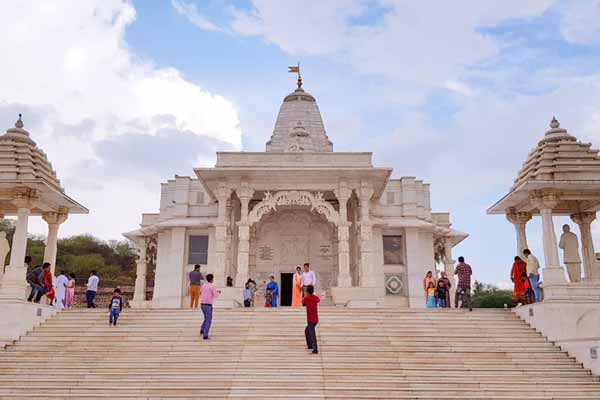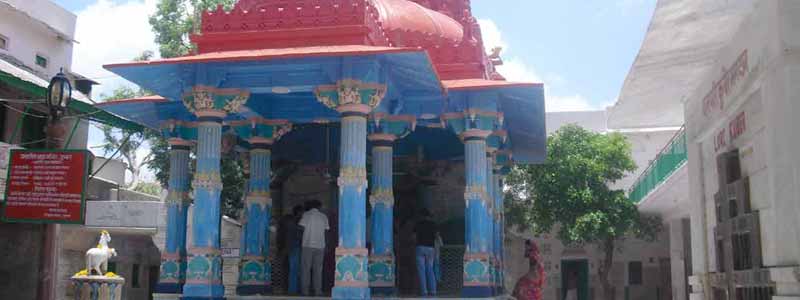Top 12 Religious Temples in Rajasthan, Eklingji Temple, Galtaji Temple, Mehandipur Balaji Temple, Sai Dham, Rani Sati Temple, Ambika Mata Temple, Ranakpur Jain Temple, Dilwara Jain Temples, Ajmer Sharif, Govind Dev Ji Temple, and more. Birla Mandir, Brahma Temple, Karni Mata Temple,
The religious sites in Rajasthan, too, are exuberant, colorful, and royal in nature, like the state itself. The Birla Mandir in Jaipur, which exhibits a perfect combination of charm, crafty craftsmanship, and aristocratic grandeur, is the best example of it! To enjoy the religious vibe of the temple, if you are looking for a very peaceful and serene environment, then the Mehendipur Balaji Mandir should be an excellent choice for you.

Apart from that, the Temple of Karni Mata is another location that provides a mix of Indian and Mughal culture. A magnificent trident is also located in it, which can be seen miles away from the eloquent shrine. Ajmer Sharif is one of Rajasthan’s most popular religious attractions and is visited every year by numerous devotees. So, if you’re thinking of traveling to Rajasthan and checking for any other religious sites, make sure you read the writing until the end!
Birla Mandir, Jaipur
This is the state’s most famous & most visited temple. Situated in the foothills of Jaipur’s Moti Dungari, this temple was built by the prominent Birla family in the 20th century. Lord Vishnu or Krishna and his consort, Lord Lakshmi, are dedicated to this shrine. There are three domes in the temple, reflecting the three principal sects that were founded in the land.
You will find sculptures of saints of several religions within the temple, philosophers, national honour, and so on. For its delicate architecture and the calmness of the site, the temple is famous. Best time to visit this sunset temple to observe the wealth of every aspect in the architecture, evidenced by artificial lights decorating the temple. Whenever you go to Jaipur, you need to visit the temple of Moti Dungari, which is very close to Birla Mandir.

Brahma Temple, Pushkar
Lord Brahma, the founder of the universe, according to Hindu mythology, was cursed because he had no temple or sort of worship on the Planet. Therefore, a temple devoted to Lord Brahma is very difficult to find. Lord Brahma will not be erected, except in the temples where his companion, Lord Saraswati, is seen. For Lord Brahma, there are a few temples in the world and the greatest of all is the Brahma temple of Pushkar.
This temple, also known as Jagatpita Brahma Temple, is located very close to Pushkar Lake. It is claimed the temple is more than 2000 years old. The best time to visit the temple, as per the Hindu calendar, is during Kartika Poornima. The easiest way of praying here is to take a holy dip in the lake and to give prayers or puja in the temple.
Karni Mata Temple, Bikaner
Among foreigners, this temple is the most prominent temple in India. This temple is also known as the Rat Temple. Deshnoke 35km Bikaner is situated in the Temple. More than 25,000 black rats live at the temple of Karni Mata. The key aspect of the temple’s ritual is the feeding of rats called kabbas. A rat statue of solid silver is placed in the temple complex if a rat is killed. The primary prasadam in this temple is rat food that is nibbled. During both Navratras days, the perfect time to visit the temple.
Eklingji Temple, Udaipur
This temple from the 8th century is located in the western part of India, in Udaipur. The temple complex, enclosed by high walls, is equipped with 108 temples. Today, there are few temples that remain proud of. The core component of the complex is the temple of Lord Shiva. This is a very significant pilgrimage site. You will find many people offering sacrifices to Lord Shiva if you visit this temple during Mondays. This temple’s best time to visit is during Maha Shivaratri. Dependent on the lunar calendar, the date for Shivaratri varies every year.
Ranakpur Jain temple
During the 15th century, a Jain merchant named Dharna Shah built this temple. This temple is devoted to Jain guru Adinath . This temple is made of white marble and is one of Jain’s largest and most prominent temples. It is situated in Rajasthan’s Pali district and falls between Jodhpur & Udaipur and is very popular with all travelers going to Jodhpur & Udaipur. The temple campus contains many temples, such as the Temple of Chaumukha, the Temple of Surya, the Temple of Parsavanth and the Temple of Amba, etc.
Dilwara Temples, Mount Abu
One of the finest Jain temples recognised worldwide for its extraordinary architecture and wonderful marble stone carvings, Dilwara Jain Temples is often considered by some experts to be architecturally superior to the Taj Mahal. From outside, it appears to be a fairly simple temple, but every cloud has a silver lining, the temple interior displays at its finest the incredible work of human craftsmanship. Such temples were built between the 11th and 13th centuries AD, providing a very nice feeling to the lovely lush green hills around the temple.
The ornamental details of the carvings of marble stone are phenomenal and unmatched, and the minutely carved ceilings and pillars are just fantastic. All this was achieved at a time when no transportation or roads were possible in Mount Abu at an altitude of 1200+ Mtrs. Large blocks of marble stones were brought to this remote hilly area of Mount Abu on elephant backs from the Arasoori Hills at Ambaji. The temples of Dilwara are a famous Jain pilgrimage attraction, too.
Rani Sati Temple, Jhunjhunu
Even now, with great pride and devotion, the people of Rajasthan narrate the story of Rani Sati, also known as Dadi Ji. Located in the Jhunjhunu district of Rajasthan, the Rani Sati Temple is dedicated to her heroism and bravery. Rani Sati committed self-immolation after the death of her husband, one of the characters in the Hindu mythological epic, Mahabharata, thereby demonstrating her unflinching devotion to him.
The temple is constructed from pure white marble and graced by the sight of beautiful paintings. The lack of any statues, either of male or female gods, is a conspicuous characteristic of the temple. Instead, a trident is housed in the sanctum sanctorum, which symbolises force, vigor, determination and courage. There are other smaller temples dedicated, along with 12 smaller sati temples, to Lord Hanuman, Lord Shiva and Lord Ganesha. Twice a day, once in the morning and once in the evening, An Aarti is held at the temple.
Galtaji temple, Jaipur
The Galta Ji Temple, considered to be a highly holy pilgrimage of considerable historical significance, lies 10 kilometers east of Jaipur District. The complex of temples is essentially a cluster of many temples, the largest temple being Galta Ji. The temples are constructed in the Aravalli hills inside a small crevice of a mountain pass.
There are many holy tanks in the temple complex that are locally called Kunds and are used for bathing by pilgrims and thus washing away their sins. The kunds are filled by means of a natural spring that rises high on the hills and fills all seven holy kunds, working its way downward. The Galta Kund is regarded as the holiest of all the Kunds here, As it is known to have never dried up before now, it also has considerable meaning.
Salasar Balaji Temple in Salasar
The temple of Salasar Balaji is dedicated to Lord Hanuman. It is situated in Salasar, in the Rajasthan district of Churu. It attracts a lot of devotees every day as it is among the popular religious places. In 1754 AD, this ancient temple was built, and there is an idol of Lord Balaji, Lord Hanuman’s incarnation. There are distinct pujas and offerings that exist during the day in this temple.
The story behind the building of this temple is that a statue of Lord Hanuman emerged after he was satisfied with the dedication of Shri Mohan Das Maharaj. This statue of Lord Hanuman appeared in the village of Asota and was later moved to Salasar, where the temple was also installed.
During the Chaitra and Ashwin Purnimas, the best time to visit this temple is There are two main festivals that are celebrated with a great deal of passion.
There are a few more temples in the vicinity that could be protected after visiting this temple. For example, you can check out the temples of Anjana Mata and Mohan Mandir,
Tanot Mata Temple, Jaisalmer
In Jaisalmer, Tanot Mata Temple is situated very near to the frontier as well as close to the Longewala battle site in Rajasthan’s Thar Desert. Tanot Mata, believed to be a manifestation of Goddess Hinglaj, is devoted to the temple. The same temple you’ve actually seen often in the Bollywood ‘Border’ movie, Tanot Mata Temple or Mateshwari Tanot Rai Mandir. Despite the heavy bombardment by Pakistan during the Indo-Pak War of 1971, the Tanot Mata temple remained untouched. Those unexploded bombs can actually be seen in the museum of the Tanot Mata Temple. This increased the confidence of people that the temple was protected by Goddess Tanot at all times.
Bullet Baba Temple, Jodhpur
You will be exploring several temples during your religious visit to Rajasthan, all of which have certain customs and history associated with them. The Bullet Baba Temple, though, is distinct from any kind of temple that you might have come across. This temple is also known as Om Banna, or Bullet Banna, and is situated in the Plai district of Jodhpur. It is meant for a motorcycle, or more precisely for a motorcycle, The Royal Bullet 350cc motorcycle. Really, you will know the fascinating story behind it after attending the temple.
A man named Om Banna, also called Om Singh Rathore, is said to have travelled to a village called Chotila on 2 December 1991. Suddenly, he totally lost control of the vehicle, causing it to crash into a tree, instantly killing him. The next morning, the motorcycle was driven by the villagers to a police station near the crash spot. The next day, though, it was noticed at the scene of the crash.
The police took the motorcycle to the police station this time, with the same result. The villagers named it a miracle and erected a temple to show their gratitude. Today, someone who passes the temple always stops at the temple and offers his prayers. Beer is given by some devotees, while some apply verminion and garland. Ok, what can we say but that in the state of Rajasthan, miracles abound.
Ajmer Sharif Dargah in Ajmer
One of the most Ajmer Sharif Dargah Department is a region of Muslim worshipers, but people from numerous other cultures frequent this place in mass numbers as well. This Sufi saint is believed to have originated from Persia and died after capturing all hearts in Ajmer in 1236. The last calming spot for ‘Garib Nawaz’ or Khwaza Moinuddin Chishti is known to be this place. This is located below in the Ajmer region of Rajasthan where individuals of all faiths come to participate in the annual Urs. Urs is a festival that comes from the religion of Muslims, but is actively celebrated by all cultures and denominations. It will be celebrated for three days.